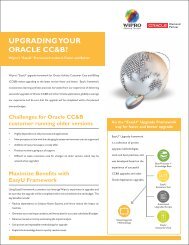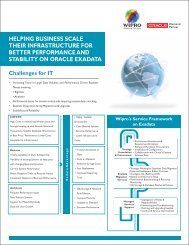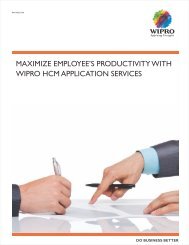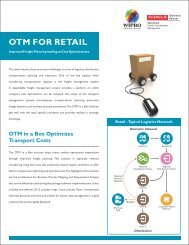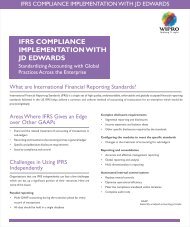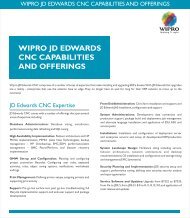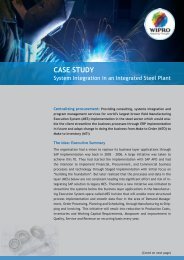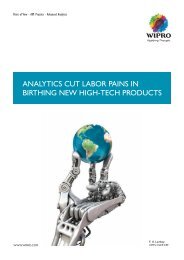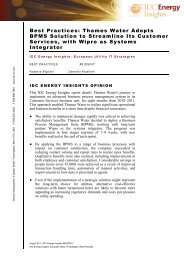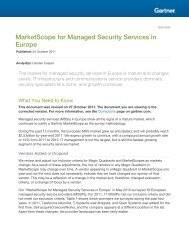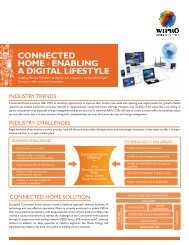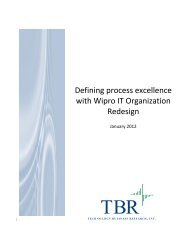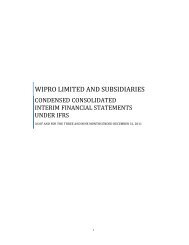Create successful ePaper yourself
Turn your PDF publications into a flip-book with our unique Google optimized e-Paper software.
GREEN IT<br />
WIPRO INSTITUTE FOR INDUSTRY RESEARCH<br />
THE GREEN DATA CENTER<br />
WHERE ECOLOGY MEETS ECONOMY<br />
We truly live in an information age. Data Centers serve a very important<br />
purpose—they provide the global community with nearly unlimited access to<br />
almost any kind of information we can imagine. The problem is that they consume<br />
great amounts of power, which can cause emissions that impact our environment.<br />
The argument can be made that the Data Center itself can facilitate enough online<br />
transactions to prevent people from using their cars or consuming precious<br />
resources that will more than outweigh the impact of running the computing<br />
equipment necessary to serve data across the net. But, we can do more to protect<br />
our environment.<br />
Eco-friendliness is mission-critical to our future. That said, the industry feels that<br />
the way forward is to make Data Centers GREEN. There are a number of initiatives<br />
that Wipro supports in this paper to help foster the convergence between the<br />
economy of conserving power and the ecology of maximizing computing resources to<br />
reduce environmental impact.
Abstract<br />
The Green Data Cente: Where Ecology Meets Economy.<br />
We truly live in an information age. Data Centers serve a<br />
very important purpose—they provide the global<br />
community with nearly unlimited access to almost any<br />
kind of information we can imagine. The problem is that<br />
they consume great amounts of power, which can cause<br />
emissions that impact our environment.<br />
The argument can be made that the Data Center itself can<br />
facilitate enough online transactions to prevent people<br />
from using their cars or consuming precious resources<br />
that will more than outweigh the impact of running the<br />
computing equipment necessary to serve data across the<br />
net. But, we can do more to protect our environment.<br />
Eco-friendliness is mission-critical to our future. That<br />
said, the industry feels that the way forward is to make<br />
Data Centers GREEN. There are a number of initiatives<br />
that Wipro supports in this paper to help foster the<br />
convergence between the economy of conserving power<br />
and the ecology of maximizing computing resources to<br />
reduce environmental impact.<br />
This paper will critically examine the means to maximize<br />
your Data Center’s efficiency by providing you with a<br />
green perspective of your computing environment. Our<br />
goal is to give you the tools so you don’t waste<br />
unnecessary power serving applications people don’t use.<br />
Going green also means increasing the effectiveness<br />
of power consumed in cooling the systems of your<br />
Data Center.<br />
Once you are able to look at your entire Data Center<br />
environment—it becomes clear how you can make it<br />
operate leaner and more efficiently. The way forward is to<br />
follow a green path where no processing cycle goes to<br />
waste. The result allows you to provide the same level of<br />
information from your Data Center, but with significantly<br />
less environmental impact.<br />
Wipro Council for Industry Research
Contents<br />
The Green Data Cente: Where Ecology Meets Economy.<br />
Introduction 1<br />
Environmental Impact 1<br />
What if... 1<br />
How does Wipro define a "Green" Data center? 2<br />
Green Data Center metrics 2<br />
How to make the Data Center greener 3<br />
Reduce Wasted Energy 3<br />
Consolidation and Virtualization 3<br />
Managing Energy Efficiency 5<br />
Capacity Planning 5<br />
Conclusion 6
A Data Center answers the<br />
fundamental need for information.<br />
You can accomplish this goal by<br />
being good to the environment as<br />
well as your bottom line. This<br />
paper will demonstrate how “going<br />
green” is good for both the<br />
economy as well as the ecology!<br />
The Green Data Cente: Where Ecology Meets Economy.<br />
Introduction<br />
Both business and environmental goals are merging. Reducing<br />
both cooling and energy consumption equates to money saved.<br />
Companies go green not just because it is the right thing to do or<br />
that it is “expected” but because it reduces costs and increases<br />
earnings potential. Reducing the power requirements for Data<br />
Centers can mean less operating expenses and greater<br />
efficiency.<br />
A Data Center answers the fundamental need for information.<br />
You can accomplish this goal by being good to the environment<br />
as well as your bottom line. This paper will demonstrate how<br />
“going green” is good for both the economy as well as the<br />
ecology!<br />
In today’s environment, it is very clear that we must go green.<br />
However, following the path is not always easy. Many<br />
companies are either highly encouraged or forced to go green<br />
sooner. This is often due to regulations imposed by<br />
governmental agencies.<br />
Environmental Impact<br />
In the next couple of years, Data Centers are likely to release as<br />
much carbon in the atmosphere as the entire airline industry.<br />
This often makes Data Centers a target of environmentalists.<br />
However, it is important to note that over the long run, the<br />
byproducts resulting from a Data Center are far less damaging<br />
than the alternative.<br />
What if…<br />
For example, let’s say eBay did not exist. People would find it<br />
necessary to get in their cars and physically drive to the auction<br />
house. The emissions produced by all of these vehicles would<br />
far exceed the emissions produced from a Data Center. The idea<br />
is that a good Data Center can digitize multiple business<br />
processes in an online environment as opposed to the “real<br />
world.” The end result is that Data Centers produce a more<br />
“ecologically friendly” environment that actually does good.<br />
Wipro Council for of Industry Industry Research Research<br />
10 1
How does Wipro define a<br />
“Green” Data Center ?<br />
Ecologically responsible members of an<br />
organization look to define an accurate<br />
Its all about reducing the amount<br />
of emissions by maximizing the<br />
usefulness of the data center so<br />
that no energy cycle goes to waste.<br />
measurement that combines all the topics<br />
covered in this white paper to produce work with<br />
the greatest efficiency possible. Wipro is working<br />
to define a green data center with a metric than<br />
can determine the good ratio of useful work<br />
completed vs. ecological impact caused to the<br />
environment.<br />
Green Data Center Metrics<br />
What is a good metric to measure a green Data<br />
Center? Wipro’s recommended metric is the<br />
Power Usage Effectiveness, which is known as the<br />
Green Grid standard. Determining and improving<br />
this metric will help the organization determine<br />
and create a more efficient computing model.<br />
This translates to delivering more effective<br />
services for every dollar spent.<br />
This measurement determines the effectiveness<br />
of your Data Center by measuring the energy used<br />
by the IT equipment as well as all the ancillary<br />
equipment. . The objective is to make the<br />
environment better while also getting useful<br />
work done.<br />
PUE =<br />
TOTAL FACILITY POWER<br />
TOTAL IT EQUIPMENT<br />
The Green Data Cente: Where Ecology Meets Economy.<br />
POWER<br />
Total Facility Power (TFP) is the power being provided to the Data<br />
Center<br />
Total IT Equipment Power (IEP) is the power used by the IT<br />
equipment in the Data center such as Storage equipment, Servers,<br />
Networking equipments, Desktops, Laptops, KVM Switches, and<br />
Display Units etc. Considering increased computing demands as<br />
well as high-density computational environments, the power<br />
distribution defined by PUE is the most critical factor.<br />
For example, if you’re PUE score is 2, then the Data Center’s<br />
power demand is two times greater than the energy required for<br />
powering the IT equipment. A PUE value approaching 1.0<br />
indicates 100% efficiency (i.e. All Power used by IT Equipment<br />
only), which is however impossible to achieve, since some power<br />
would be taken up by ancillary equipment, Data Center lighting<br />
and due to distribution losses.<br />
You might ask, “How much did I impact the environment for every<br />
unit of useful work accomplished by my Data Center? It really<br />
isn’t measuring how much you degrade the environment, but<br />
rather reducing the amount of emissions by maximizing the<br />
usefulness of the Data Center so that no energy cycle goes<br />
to waste.<br />
Wipro Council for Industry Research<br />
2
Wipro’s Recommendation<br />
Wipro’s recommended PUE for a Green Data Center is in the<br />
range of 1.4 to 1.6. When the PUE increases beyond 1.6, it is<br />
indicative of the need to improve energy efficiency.<br />
How to make<br />
the Data Center greener<br />
i. Reduce Wasted Energy<br />
There are ways in which you can make your Data Center greener<br />
just by getting rid of server applications that “eat” energy, but<br />
are not producing any business benefits.<br />
Consolidation of multiple applications and application instances<br />
on a single server provides numerous benefits which include<br />
increased server utilization,<br />
Generally about elimination of redundancies,<br />
10% of a company’s increased performance and reduced<br />
applications are not maintenance costs. This would<br />
doing any useful eliminate the applications which<br />
work.<br />
exist in the inventory and are not<br />
being used. Generally about 10% of<br />
a company’s applications are not doing any useful work. There<br />
could also be redundancies in IT utilisation as a by- product of<br />
mergers and acquisitions which need to be rationalized.<br />
Wipro Recommendations<br />
Wipro offers a comprehensive Application Rationalization<br />
solution that addresses both IT and Business problems through<br />
an end-to-end transformation approach. The recommended<br />
steps are:<br />
Perform a detailed analysis of the application inventory and<br />
build a repository of application inventory<br />
Map applicatations<br />
Conduct a 360 degree assessment and develop<br />
The Green Data Cente: Where Ecology Meets Economy.<br />
scores for business value, technical value, cost<br />
and risk<br />
Identify opportunities to decommission, migrate,<br />
consoli date and modernize, based on the scores<br />
Lastly, design an application life cycle assessment<br />
or APM process integrated with internal<br />
investment budgeting and control<br />
ii. Consolidation and Virtualization<br />
Virtualization can make your Data Center leaner just<br />
by driving server utilization up. Most applications are<br />
running on machines with more horsepower than the<br />
program could ever possibly use. You can solve this<br />
problem by running multiple applications on just one<br />
server running virtualization software. Instead of<br />
running 10 servers at only 5% utilization, you can run<br />
just one server running at 80% utilization and unplug<br />
all the rest.<br />
Wipro Council for Industry Research<br />
3
Case Study<br />
Company Power Transmission & Distribution, Retail Power, and Natural Gas<br />
Location UK<br />
Objective Outsource their Data Center Management and Transforamation<br />
Goal Factor Environmental Parameters into their plans<br />
Revenue Over $1 Billion (USD)<br />
Personnel Employs over 1500 people<br />
Global Locations 20 subsidiaries in the UK<br />
In the following case, Wipro has taken several prominent<br />
initiatives to reduce the Data Center PUE. The client had<br />
an IT estate where the Total Facility Power was 1259 KWh<br />
(including power used both by IT equipment as well as<br />
ancillary items such as chillers and lighting), then the<br />
total power consumed ONLY by the IT equipment is 547<br />
kWh—generating a PUE value of 1259/547= 2.3.<br />
In the following chart, you can see the percentage impact<br />
of various Consolidation and Virtualization initiatives on<br />
Storage Consolidation 3.11%<br />
Asset Refresh<br />
Desktop Virtualization<br />
UNIX Consolidation<br />
Network Consolidation<br />
Wintel Server Virtualization<br />
Data Center Upgrade<br />
Initiatives VS. Impact on PUE<br />
5.35%<br />
The Green Data Cente: Where Ecology Meets Economy.<br />
13.83%<br />
16.69%<br />
18.00%<br />
18.59%<br />
the PUE.<br />
In the below graph, weightage is based on Wipro’s industry<br />
expertise. This metric is represented that resolving<br />
any one of these initiatives can reduce PUE by the corresponding<br />
percentage on the graph. This percentage can<br />
vary proportionally to the Data Center volumetric.<br />
This client reduced 80% Windows Based Intel Servers<br />
through the consolidation of 47 Wintel Servers to 10<br />
Wintel Servers.<br />
46.00%<br />
0% 5% 10% 15% 20% 25% 30% 35% 40% 45% 50%<br />
Weightage<br />
Wipro Council for Industry Research<br />
4
Energy Savings Resulting from Server Consolidation:<br />
DESCRIPTION ORIGINAL REVISED<br />
Number of Servers 47 10<br />
Power (kWh/year) 288,204 61,320<br />
Cooling (BTU/Hour) 112,288 23,891<br />
Carbon Emissions 34 7<br />
Racks 5 1<br />
Total Savings 80%<br />
Wipro Recommendations<br />
Storage, servers, and network equipment can all be<br />
consolidated based on both peak and average<br />
utilization. Consolidating several underutilized<br />
machines into high-end devices as well as<br />
rationalizing several instances of Operating<br />
Systems, Databases, and Applications can also<br />
bring down your PUE.<br />
Wipro’s Green Data Center deals with end-to-end<br />
server, storage, and network technology services.<br />
This includes assessments, virtualization planning,<br />
evaluation & selection of product solutions, system<br />
integration, testing, and management. Energy is<br />
also conserved by using components including<br />
occupancy sensors, auto vents, ambiators, and<br />
building management sensors.<br />
iii. Managing Energy Efficiency<br />
Usually, running an efficient system, where not a<br />
single Watt is wasted, can dramatically cut costs.<br />
“Chillers” and Computer Room Air Conditioners<br />
(CRACs) consume a great deal of energy moving air<br />
around to keep the Data Center cool. CRACs draw<br />
in air and force it under a raised floor. The air then<br />
comes out through planned perforated floor tiles.<br />
Air is drawn into the server and then evacuated out<br />
of the back of the server. The CRAC draws the hot<br />
air back into the unit and cools it down for<br />
recirculation. Problems can result when hot air is<br />
continually drawn back into the server where it can<br />
cause damage to the IT equipment.<br />
Cooling is one such system which can help reduce<br />
The Green Data Cente: Where Ecology Meets Economy.<br />
the overall Data Center expense.<br />
Wipro Recommendations<br />
Wipro designs Data Centers for Customers that take into<br />
consideration various factors such as the air flow, areas of heat<br />
generation and cooling. A few key aspects of Data Center design are:<br />
The concept of “Hot Aisle Containment” can help reduce<br />
energy consumption. There will be a self contained glass unit<br />
located behind the server row which captures heat. The air<br />
conditioning is located either in or above the row designed to<br />
take hot air within its enclosure and push it into a general row.<br />
The idea is not to move the cold air very far because the air can<br />
be cooled right at the source—all while using less energy!<br />
Repositioning floor tiles to efficiently manage cold airflow<br />
Install seals and grommets in the ceiling, walls, and floors (this<br />
reduces bypass airflow)<br />
Install “blanking plates” in the server cabinets to direct airflow<br />
more efficiently<br />
Seal cracks and crevices around power distribution devices<br />
Reduce the number of CRAC’s by moving cold air where it needs<br />
to go instead of cooling the Data Center over capacity.<br />
Locate the data center in a place where air or water cooling<br />
techniques can be efficiently adopted; the result can be most<br />
favorable to economic and ecology considerations.<br />
Wipro Council for Industry Research<br />
5
iv. Capacity Planning<br />
CIO’s face a constant challenge in determining<br />
future requirements of hardware and software for<br />
a network, datacenter or even a Web site due to the<br />
pace of business growth, dynamic changes in the<br />
business environment, mergers and acquisitions<br />
and even divestments. As a result most Data<br />
Center equipment is built for larger capacity than<br />
necessary, which again consumes more power than<br />
necessary.<br />
Usage of an efficient demand management and<br />
capacity planning process to ensure availability of<br />
the right processing power and storage at the right<br />
time will greatly increase the Data Center<br />
efficiency.<br />
Conclusion<br />
Wipro Recommendations<br />
Wipro works with Customers to design, build, integrate, manage<br />
and evolve at an optimized demand management and capacity<br />
planning process. This process obtains inputs from the Customer’s<br />
strategic planning exercise and then converts this into an<br />
operational IT Plan and hence the Demand.<br />
From a technology standpoint, Wipro recommends Thin<br />
Provisioning, a green storage technology that dramatically cuts<br />
disk capacity, energy, and floor space costs while substantially<br />
alleviating storage and system administration on Storage Area<br />
Network; Capacity is dedicated and configured in small<br />
increments from a single, non dedicated, comprehensively<br />
scalable pool—enabling customers to provision storage<br />
efficiently and without waste.<br />
We are at the crossroads where ecology meets economy. Data Centers are a very necessary fabric of our IT society.<br />
Although critics state that there mere existence can adversely impact our environment, it can be successfully argued in<br />
this paper that Data Centers do more good than harm. Without the online nature of information distribution, people<br />
would be forced to use far more natural resources just to accomplish daily activities that are now done online.<br />
Furthermore, there are a number of techniques described in this paper such as virtualization and cooling conservation<br />
that can make a new or existing Data Center work leaner while at the same time being more energy efficient.<br />
Data Centers are an important fact of life—making them go greener is good for your wallet as well as the environment…<br />
The Green Data Cente: Where Ecology Meets Economy.<br />
Wipro Institute Council for of Industry industry Research<br />
6




